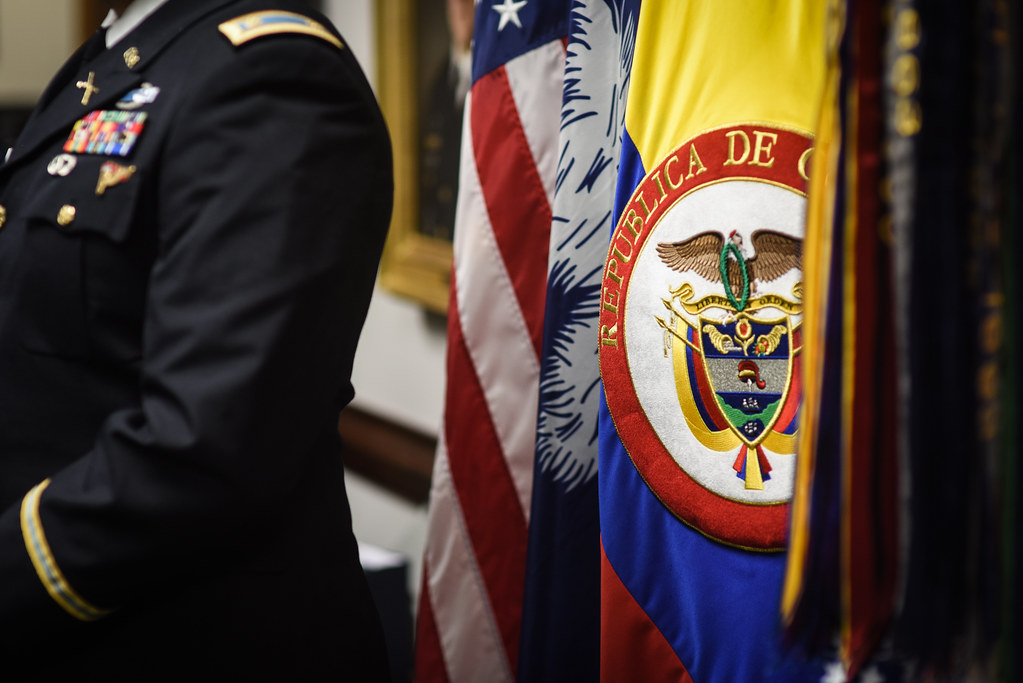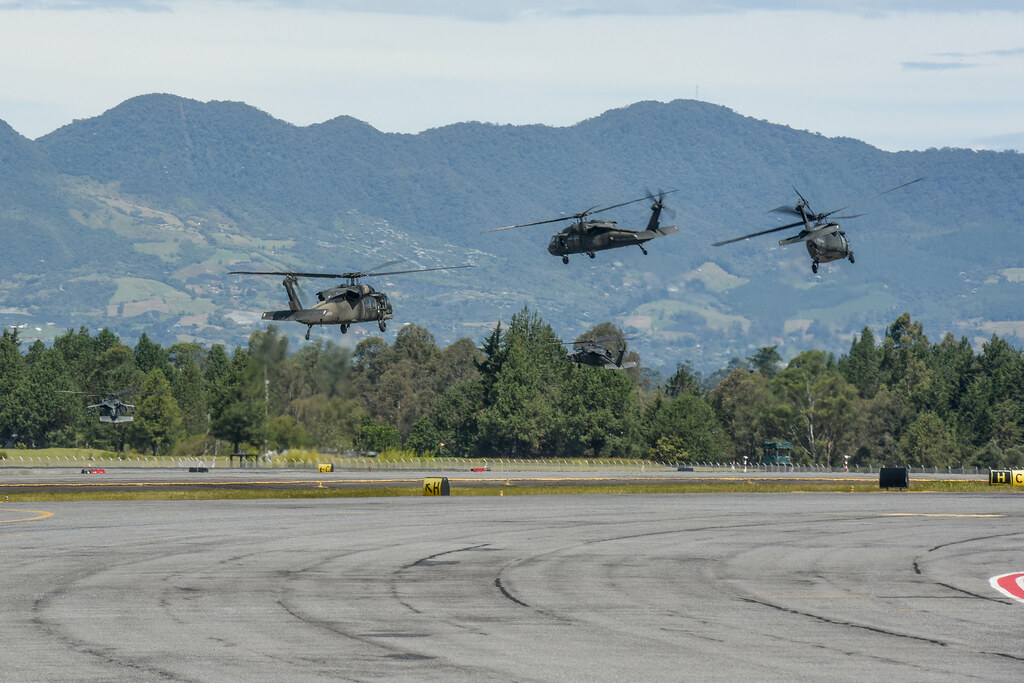
The US – Colombia relationship is a crucial element in Colombian domestic and foreign policy. As the US is Colombia’s oldest ally, it has been a pivotal element in its foreign policy for over a century. Originating from geopolitical interests and shared challenges, this alliance has evolved throughout history, from the controversial secession of Panama to modern-day concerns such as drug trafficking and the migrant crisis. In this article, we will explore the complexity of the US-Colombia relationship, highlighting its origins and main characteristics.
Colombia’s historic geopolitical alignment with the US
Since the early 20th century, the United States has been Colombia’s major ally. The rapprochement between the two countries paradoxically occurred after a crisis—the secession of Panama. Part of Colombian territory, Panama gained its independence in 1903 due to significant pressure from the United States, which had plans to construct the future canal there. Rather than harboring vindictive rivalry towards the United States, Colombian elites chose to accept the status quo and even strengthen their ties with the North American power.
This decision is encapsulated in a Latin expression that has remained famous, Respice Polum, literally “look towards the North Star.” Coined by future President Marco Fidel Suárez (1918-1921) in his article ‘The treaty with the United States’ (El tratado con los Estados Unidos) on May 31, 1914, this phrase means “let’s not lose sight of our relations with the great confederation of the north.” This stance reflects a geopolitical realism that involves accepting regional power dynamics, and, therefore, U.S. dominance. Thus, this expression crystallizes the almost constant alignment of Colombian foreign policy with the United States throughout the 20th century.
While this closeness initially manifested economically, it was mainly on the political and diplomatic fronts that it subsequently became evident. During the Cold War, Colombia was the only South American country to send troops to the Korean War (1950-1953) and was, from 1949 to 1974, the second-largest recipient of U.S. military assistance after Brazil.
However, this alignment was neither constant nor total. Several shifts occurred in Colombian foreign policy, especially under Alfonso López Michelsen, first as Foreign Minister (1968-1970) and then as President (1974-1978). In response to Respice Polum, he introduced Respice Similia, “look towards one’s peers,” which led to closer ties with South American neighbors and a diversification of foreign policy partnerships, notably through the Andean Pact of 1969. Nevertheless, there was never a complete break with the United States. While Colombia could occasionally diversify its partnerships, its alliance with Washington remained.
Plan Colombia and the strengthening of the US – Colombia relationship
The presidencies of Andrés Pastrana (1998-2002) and Álvaro Uribe (2002-2008) marked an unprecedented intensification in the history of relations between the two countries. Faced with the Colombian state and security apparatus’s incapacity against guerrillas, both presidents successively internationalized the armed conflict. The aim of this policy was to involve external actors in the conflict to compensate for the structural weaknesses of the Colombian military and administration. Due to their significance in Colombia’s geopolitical vision, the United States became the primary focus of these expectations. To secure Washington’s help in a war it had proven incapable of winning alone, Colombia adopted a rhetoric that linked its national security issues with those of the United States. Thus, Colombia durably aligned itself with U.S. foreign policy.
This process began with Andrés Pastrana, who decided to connect the fight against guerrillas with the international fight against drug trafficking led by the United States. Leveraging the Colombian guerrillas’ ties with narcotraffic, President Pastrana secured an increased commitment from the United States to Colombia in the name of their own national security. This is what researcher Arlene Tickner describes as “intervention by invitation,” meaning foreign interference requested by the country. In June 2000, under Bill Clinton’s presidency (1993-2001), Congress voted to implement Plan Colombia, an aid plan of just over a billion dollars aimed at supporting the Colombian state in its fight against the guerrillas. Plan Colombia significantly increased U.S. influence in the country, especially militarily, with 80 percent of the aid amount allocated to strengthening the Colombian security apparatus and state.
This dynamic of Colombia’s alignment intensified after the September 11, 2001, attacks. Indeed, Colombia saw it as an opportunity to involve the United States even more in the armed conflict by integrating it into President George W. Bush’s (2001-2009) War on Terror. Following Andrés Pastrana, it was Álvaro Uribe who pushed the Colombian alignment with the United States to its peak. Under his presidency, Colombia would thus support the invasion of Iraq in October 2003, in the name of the war against terrorism, which it claimed to be part of by fighting the guerrillas. This alignment enabled an intensification of the military response to the conflict with the launch of Plan Patriota against the FARC in 2002.

The Trump years, doubts and cooperation
Under the presidency of Donald Trump, while relations between the two countries somewhat eroded, political and military ties were reinforced in light of the Venezuelan crisis. Thus, although Donald Trump provoked an unprecedented decrease in aid to Colombia, with only US$251.4 million allocated in 2018, the lowest amount since 1998, the alliance with Colombia took on a new dimension. On May 31, 2018, Colombia became NATO’s ninth global partner and the first in Latin America, and on April 23, 2020, Colombia became a member of the OECD, evidence of its ever-deepening ties with the United States.
With the coming to power of Ivan Duque, a senator very close to former President Álvaro Uribe, on August 7, 2018, Colombia followed the United States in its policy of ‘maximal pressure’ against Venezuela, aiming to bring down the regime of Nicolas Maduro. Thus, paradoxically, geopolitical circumstances have sustained strong ties between Colombia and the U.S., despite tensions under Trump’s administration. As such, one notable point of tension between the two countries was President Trump’s criticism of his Colombian counterpart for inaction and passivity on drug trafficking and coca plantation eradication programs. This led to the deployment of U.S. destroyers and surveillance aircraft in the Caribbean Sea in April 2020, and the deployment of the SFAB, a U.S. special forces unit, in May 2020, as part of anti-drug efforts.

Gustavo Petro, nothing new under the sun?
In 2022, Gustavo Petro’s election as President of Colombia sparked discussions about the future of US-Colombia relations. With Petro’s progressive and leftist approach, there were expectations of changes in Colombia’s domestic and foreign policies, including its relationship with Israel. Petro, taking a different path from his predecessor, Ivan Duque, who navigated relations with a right-wing American administration, is now engaging with Democratic President Joe Biden. This alignment has mitigated major conflicts and tensions. Consequently, the ties between Colombia and the US have maintained a level of balance, despite some areas of disagreement.
Tensions include Gustavo Petro’s approach to drug trafficking, an issue of first concern to the US. As such, under Gustavo Petro, Colombia has shifted from traditional anti-narcotics strategies, leading to a reduction in the eradication of coca plantations from 69,000 to 20,000 hectares, and an increase in coca cultivation, resulting in tensions and pressure from the US. Similarly, the migrant crisis ongoing in the Gulf of Uraba is also being monitored by the US as the flows are concentrated towards its southern border.
Regardless, Colombian policies have found common ground with the US under Biden’s administration, particularly on environmental and climate change issues, as well as the Venezuelan crisis. Petro’s more conciliatory stance towards the Maduro regime has coincided with the US easing sanctions on Venezuela. In addition, it seems that the US still conserves its influence on Colombia’s military, as a recent interview from a Colombian airforce commander revealed that US pressures were blocking negotiations with Russia about the maintenance of Colombian Russian-made aircraft.
To conclude, the US-Colombia relationship is characterized by a certain imbalance in favor of the United States, the historical superpower. While Colombian alignment is never absolute and should be nuanced, the alliance between the two countries remains firm and endures through the eras and political orientations of different presidents, from Bill Clinton to Donald Trump, and from Álvaro Uribe to Gustavo Petro. In addition to the historical and political elements presented, the United States is also Colombia’s foremost commercial partner and the leading investor in the country, with a significant Colombian diaspora living in the USA, which completes the deep ties uniting the two nations.
See all the latest news from Colombia and the world at ColombiaOne.com. Contact our newsroom to report an update or send your story, photos and videos. Follow Colombia One on Google News, Facebook, Instagram, and subscribe here to our newsletter.

